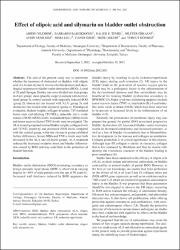Effect of alpha lipoic acid and silymarin on bladder outlet obstruction

Göster/
Erişim
info:eu-repo/semantics/openAccessTarih
2013Yazar
Yıldırım, AbidinBaşesikoğlu, Barbaros
Temel, Halide Edip
Erkasap, Nilüfer
Yenilmez, Aydın
Uslu, Sema
Dönmez, Turgut
Üst veri
Tüm öğe kaydını gösterÖzet
The aim of the present study was to determine whether the treatment of obstructed rat bladders with alpha lipoic acid (ALA) and silymarin reverses the biochemical and physiological responses to bladder outlet obstruction (BOO). A total of 32 adult Sprague Dawley rats were divided into four groups (n=8 per group): sham (placebo surgery) animals with no treatment (group 1); control animals with surgically induced BOO (group 2); obstructed rats treated with ALA (group 3); and obstructed rats treated with silymarin (group 4). Histological evaluation, bladder weights, collagen structure, TdT-mediated biotin nick end-labeling (TUNEL), inducible nitric oxide sentase (iNOS) mRNA levels, malondialdehyde (MDA) levels and tumor necrosis factor (TNF) levels were investigated. The ALA-treated group had similar bladder weights, collagen levels and TUNEL positivity and decreased iNOS levels compared with the control group, while the silymarin group exhibited further differences. Serum MDA and TNF-alpha levels were both decreased in the ALA and silymarin groups. ALA treatment reduced the increased oxidative stress and bladder inflammation caused by BOO and may contribute to the protection of bladder function.

















